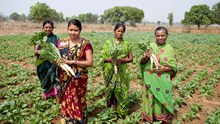
Balasaheb Lomte, a farmer from the drought-prone region of Marathwada, had spent most of his life caught in a cycle of failing crops, deepening debt, and seasonal migration to Mumbai for survival. After a personal tragedy shook his already fragile world, Lomte found himself with no choice but to return to his barren land and try once more. That turning point came when he encountered the JalTara project by The Art of Living, a water conservation initiative inspired by the vision of Gurudev Sri Sri Ravi Shankar. On this World Environment Day, his journey stands as a powerful testament to how grassroots initiatives in water conservation can transform lives and restore hope.

What began as a desperate experiment- digging a few simple recharge pits- soon revived not only his borewells, but also his livelihood, resilience, and hope. His story reflects the power of grassroots solutions rooted in compassion, community, and the belief that healing the land begins with healing the heart.
From Despair to Hope: A Farmer's Turning Point
“When your heart opens up, you cannot but serve,” says the global spiritual master and humanitarian Gurudev Sri Sri Ravi Shankar. And it is by changing hearts, bringing peace in the minds of millions of volunteers first, that Gurudev has inspired climate action worldwide, and the results of this collective endeavour have been miraculous and moving.
When climate change makes headlines, it’s often in the language of carbon credits, sea-level projections, and industrial reforms. But in places like Marathwada, the crisis is personal. Here, in central India, erratic monsoons, groundwater depletion, and shrinking incomes have steadily chipped away at rural resilience.
Balasaheb Lomte, a second-generation farmer, tends to 16 acres of farmland in a hilly terrain that has no natural lake, canal, or water body in sight. For most of his adult life, he followed a predictable routine: six months of struggling with rain-fed agriculture, and the rest of the year working as a labourer in Mumbai to make ends meet for his family of five. Like most farmers in the region, Lomte had gradually resigned himself to failing borewells, shrinking yields, and growing debt.
Then, three years ago, a personal tragedy struck. Lomte’s eldest son, who worked in a factory and supported the household, was killed in an accident on his way home for Diwali. The loss was sudden and devastating but there was no time to grieve. Someone needed to tend the land, feed the family, and there were no lifelines left.

JalTara: A Simple Solution with Profound Impact
Around the same time, Gurudev expressed deep concern over the rising farmer suicides and the escalating distress among rural communities. He brought together a dedicated team to develop a powerful yet simple solution aimed at restoring water to the land and hope to the farmers. This initiative became the JalTara project.
Lomte heard about The Art of Living’s JalTara project, a grassroots water conservation initiative launched under the guidance of Gurudev. While most interventions in rural India arrive with blueprints and bureaucracy, this one came with shovels, stones and a sense of belongingness. Simple recharge structures dug at the lowest point in a farmer’s field were being used to trap rainwater, stopping runoff.
Skeptical but desperate, Lomte agreed to build four recharge pits across his land. Each pit was 4x4x6 feet, filled with layers of stone and gravel to allow water to seep deep into the ground, bypassing the dense topsoil that usually led to surface runoff and erosion. “We were used to droughts,” Lomte says, “but the bigger problem was that even when it rained, all the water just washed away with the mud. Nothing stayed.” Having the pits changed that. Rainwater began to collect. Within a season, the water table had started to rise. A year later, all three of Lomte’s borewells, that were once abandoned, were yielding water, even during peak summer.
He returned full-time to farming. With water secured, he expanded from jowar and wheat to include onions, soybean, and cotton. His income doubled. “Earlier, we could grow only what needed the least water. Now I can take three crops a year,” he says. He even managed to marry off his two daughters in the last couple of years. “Mentally, I am in a peaceful place again. My farm has become my life.”
India, despite generous rainfall averaging around 119 centimeters annually, faces severe water scarcity due to the over-extraction of groundwater. The Central Ground Water Board reports that India extracts about 241 billion cubic meters of groundwater each year, with more than 60 percent of it depleted regularly. Unregulated use, combined with deforestation and the disruption of natural river flows, has reduced water availability dramatically. Over 78 percent of rainfall runs off the surface, flowing directly into oceans instead of replenishing groundwater reserves that have led rivers to dry out, soil to erode, and farming to suffer.
In response to this, The Art of Living has constructed over 90,500 recharge structures which are essentially 4x4x6 feet pits built at the lowest points of a farmer’s land, and by bypassing the dense, dry topsoil, the rainwater can percolate deep underground, preventing runoff, reducing soil erosion, and protecting crops.
Lomte’s story reflects a much broader impact. Studies show, The JalTara project has resulted in raising water tables on average by 14 feet and increasing farmer incomes by over 120 percent. Crop yields have improved by 42 percent, while rural employment generated from these efforts has surpassed six lakh workdays.
“The Art of Living has not just stopped at spiritual awakening. It has gone a step forward. Wherever Art of Living has worked, the impact is clearly visible. At a community level, fights have stopped and people have come together to work. In districts like Satara, extensive watershed work has transformed villages once dependent on water tankers, into self-sufficient water rich communities.” shared Shweta Singhal, District Collector, Satara District.

Beyond Water: Power of Natural Farming
But Gurudev’s vision didn’t stop at water. He saw the deeper wound—the damage caused by chemical farming, which depletes soil, poisons rivers, and leaves farmers more dependent and less empowered.
At the Sri Sri Institute of Agricultural Sciences and Technology, farmers are taught the gentle science of natural farming—free from chemical fertilizers and pesticides, rich in ancient knowledge and indigenous practices. This method revives the soil, encourages biodiversity, and protects rivers from toxic runoff. Farmers are trained through short but intensive courses, gaining knowledge in seed preservation, soil care, and sustainable cultivation.
When farmers return to natural methods, they’re not only growing food but they’re healing the land. Lomte is among the 30 lakh farmers trained by The Art of Living in the sustainable eco-friendly method of natural farming. He has also benefited from thousands of desi seed varieties being preserved by the organization to encourage biodiversity and ensure food security. Food forests are being grown; and over 100 million trees have been planted, of which 7 lakh trees have been planted along river basins and in community spaces, contributing to soil health, air quality, and water retention.
These efforts support government missions such as Namami Gange, which aims to reduce pollution and rejuvenate the sacred Ganga River, where natural farming efforts on the embankments will eliminate chemical runoff at its source.
Permaculture for the urban food grower
Alongside natural farming, The Art of Living’s environmental efforts include bringing the knowledge of permaculture to everyone. Permaculture is a sustainable design system that mimics natural ecosystems to grow food, conserve resources, and restore the environment. It integrates plants, animals, water, and people into self-sufficient, regenerative systems. In layman's terms, it means growing food in a way that’s kind to the Earth. At the ashram in Bengaluru, thousands learn and benefit from this technique.
One such student, Nisha Agarwala from Kolkata, turned 20,000 kilos of kitchen waste into compost, Her 3000 sq. ft. terrace, now a thriving oasis, grows over 300 edible fruits, vegetables and herbs, right from sweet potatoes, cucumbers, ash gourd, spinach, to red bhindi, white brinjals, white bitter gourds and more. The fruit basket includes custard apples, guavas, chikoos and muskmelons to complement the ‘herb haul’ - coriander, celery, basil, parsley and Italian thyme, to name a few.
Balasaheb Lomte’s journey from hardship to hope exemplifies the profound impact of compassion-driven action combined with sustainable innovation. The Art of Living’s holistic methodology—focused on healing both the earth and the human spirit—proves that genuine environmental restoration is achievable when communities unite with shared purpose and care.
As this movement expands, it offers a powerful blueprint for a future where farmers prosper, ecosystems rejuvenate, and humanity coexists harmoniously with nature. In confronting global environmental challenges, this inspiring model shows us that real change arises not only from technology or policy but from awakened hearts committed to nurturing the planet and one another.
















